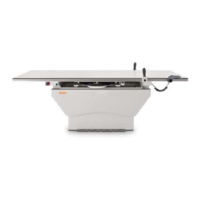Chapter 3 Theory of Operation
26
Models QT-740 & QT-750 - Service Manual
float top operation. Pressing the foot pedal operates switches S1 and S2, and
pressing the push button switch operates switch S3. When S1, S2, or S3 is acti-
vated, a negative-going level is applied through normally open (N.O.) PEDAL DIS-
ABLE switch S4 and FLOAT switch S1, S2, or S3 to A1C3, which generates a
negative-going pulse at one-shot A1U1-2 on 4-Way Table Control Board A1. One-
shot A1U1-3 produces a 47-second pulse that turns on FET A1Q1, which provides
drive current for the +24 VDC transverse and longitudinal electromagnets. The
magnets release the mechanical brakes, allowing tabletop "float" motion. After
47 seconds, or releasing the FLOAT foot pedal or push button (which applies a
negative-going level to A1U1-4, resetting A1U1) A1Q1 turns off. The magnets
de-energize and lock preventing tabletop "float" motion.
Foot Pedal Disable Circuit
A Foot Pedal Disable Switch S4 is located below the table rail on the left end of
the table. Pressing the switch until PEDAL DISABLE SWITCH lamp DS2 is illumi-
nated disconnects FLOAT switches S1, S2, and S3 thereby disabling FLOAT foot
pedal and FLOAT push button operation. When the patient is in the correct loca-
tion for x-ray, disabling the FLOAT foot pedal prevents inadvertent activation of
the pedal. When Foot Pedal Disable Switch lamp DS2 is not illuminated, the
FLOAT foot pedal and push button are fully operational.
Receptor Cabinet Lock
The Receptor Cabinet magnetic lock has its own release switch (S5) for Receptor
Cabinet positioning. When S5 is pressed, the Receptor Cabinet locking magnet is
de-energized enabling cabinet movement.
MODEL QT-750 TABLE
The table's major electrical components include the AC transformer and fuse block,
printed circuit boards, magnetic locks, and DC motor. Vertical table motion is per-
formed by a motor-driven twin lead screw assembly mounted on the table base. The
DC motor drives the twin lead screw assembly via belt connection, which extends
(upward) and retracts (downward) the Scissors Assembly when the UP or DOWN foot
pedal, respectively, is depressed. See Figures x and x in Chapter 5, Diagrams.
Power Distribution
115/230 VAC line input is applied through terminal board TB1, fuses F1 and F2,
and line filter FL1 and to AC transformer T1. Transformer T1 provides 20 VAC to
6-Way Table Control Board A1. Transformer T1 also provides 110 VAC to DC
Motor Driver A2 (AC terminals) and to 6-Way Table Control Board connector A1J1-
15 and A1J1-16.
Voltage Regulation
From AC transformer T1, 20 VAC is supplied to 6-Way Table Control Board A1 at
connector pins A1J5-1 and A1J5-3 (see Figure 27). Fuse protection for 20 VAC
input is provided by fuse A1F2. The 20 VAC is rectified and filtered by bridge rec-
tifier A1DB1 and capacitors A1C20 and A1C21 to produce 24-28 VDC unregulated
voltage. The +24 VDC is monitored by comparator A1U5B; if the voltage level
falls below 15% nominal, a motor drive inhibit signal is output from A1U5B-7

